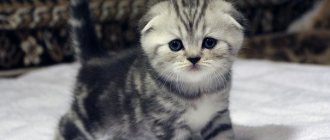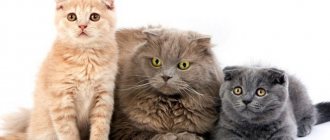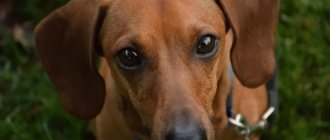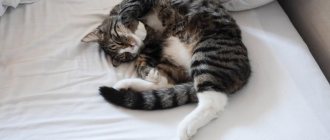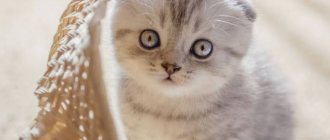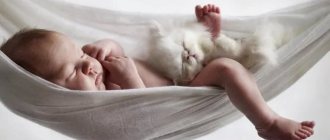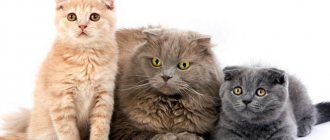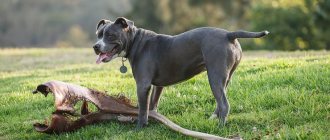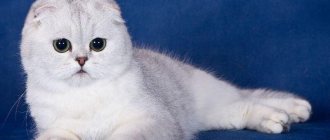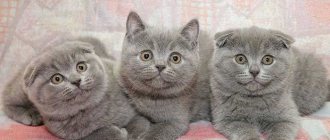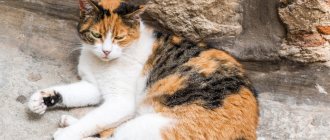Who would have thought that a simple defect would become the basis for the emergence of an incredibly cute breed? Yes, these bent ears used to be considered a cat's fault, and only in 1974 did the whole world recognize fold-eared cats as a test breed. And already in 1978 they won the hearts of every judge and spectator at exhibitions. What can we say if photographs of these cats even now receive thousands of likes on the Internet.
Kinds
Interestingly, kittens are born with straight ears, and up to 3 months they can droop on their heads. Depending on whether the ears are flattened or not, Scottish Folds are divided into 4 types:
- Scottish Straight - short hair and straight ears;
- Scottish Fold - short coat and drooping ears;
- Highland Straight - long hair and straight ears;
- Highland Fold - long coat and drooping ears;
Breed colors
Every country, and especially every nursery, works with its own favorite colors. The number of allowed options is quite large. You can choose either a single-color representative or various patterns and color marks.
Acceptable colors:
- Harlequin. On a pure white background, large markings are allowed on the back and head, the tail must be fully colored, and a different color may appear on the croup. No more than a fifth should be painted. Blue eyes are acceptable.
- Wang. Completely white except for the colored tail and a couple of spots on the head.
- Bicolor. Half of the cat is painted a different color (not white). A white closed collar is required.
- Solid white. Yellow or other shades are undesirable. Kittens are allowed to have colored spots on their heads, which should go away with age.
- Solid black. Any shade on both the coat and the undercoat (brown, ashy), as well as the presence of white hairs, is prohibited.
- Solid purple. A pinkish tint to the coat and nose is preferred.
- Solid blue. All shades are allowed, but light colors are better.
- Solid red (red). Be sure to be smooth and bright. Half rings of a light shade on the paws and a hint of a pattern on the forehead are acceptable.
- Tortoiseshell. One of the most beautiful colors. A perfect mixture of cream, red, blue, black, red and chocolate colors and shades. Preference is given to cats with a red or cream spot on their forehead. The paw pads and nose are painted in two primary colors, which predominate in the color. Kittens are allowed a smoky undercoat. Any drawings are not acceptable.
Description
Everyone has at least once seen a blue Scottish Fold cat on the Internet, their photos are incredibly popular there, so this description will be familiar to you.
The main difference from other breeds is, of course, drooping ears; this feature became the breed-forming feature. Cats of this breed are similar to plush toys in both their appearance and character, but more on that later.
The weight of Scots varies greatly depending on the sex of the animal: females weigh 4-5 kg, and males reach the level of 10 kg. They have a short and strong neck, on which there is a spherical head with flattened ears and a humped nose.
The paws are massive, but not very long, but this does not in the least interfere with the animal’s mobility. The fur is short and dense, which is why these cats are often compared to plush toys. The tail is wide, but short, while tapering towards the end.
Look - American Shorthair cat - features of the breed, description of standards, history and characteristics of the cat (95 photos)
Note!
Snowshu: description and characteristics of the cat, care and maintenance
- Munchkin: description and characteristics, care and maintenance of a short-legged cat
- Thai cat: description and characteristics, care and maintenance, choosing a kitten
Scottish Folds come in a variety of colors, from solid to striped, so you can find almost any coat pattern.
Choosing a kitten class
Breeders know that the division into classes is very arbitrary: it only helps determine the baby’s career prospects . Often kittens of the same litter fall into different classes, but this is always the personal point of view of the breeder. In addition, in the process of growth there are transitions from breed to pet, from show to breed and vice versa.
Show class (show – display, demonstration)
This includes kittens that fully comply with the breed standard, without disqualifying characteristics or shortcomings. Reference cats are included in the top show class (top – top, highest). These animals remain in nurseries for breeding and exhibition activities. Show-class kittens (the pride, decoration and advertising of the nursery) are practically not put up for sale. Such copies are sold for a lot of money and with reservations - “on conditions” or “in co-ownership”.
Breed class (breed – tribe)
This group is represented only by cats with excellent pedigrees and excellent reproductive capabilities. They also appear at shows and win titles that give them the right to participate in breeding. With proper selection, show-class offspring are obtained from such females.
This is interesting! Breeding males usually fall into the pet category, since a breeding cat is judged not so much by its pedigree and conformation, but by the health and quality of the kittens it produces.
Such animals are often sold with the condition of mandatory removal of the reproductive organs, which does not prevent them from having a pedigree and claiming exhibition regalia (in the “castrati” category). The price for breed-class cats is in the average price range. It happens that show-class kittens are found among breed-quality animals. This happens due to oversight or due to insufficient experience of the breeder.
Pet class (pet – pet)
These are purebred kittens that, in the opinion of the breeder, are not of interest either for exhibitions or for breeding. They often have disqualifying defects that do not threaten health or life.
Such kittens are sold already neutered or with the condition of spaying. A pedigree for a pet-class animal is issued only at the request of the buyer: in this case, the entry “not for breeding” appears in the documents. The cost of pet quality kittens is the lowest.
Return to content
Character
The character of the Scottish Fold will appeal to many. These animals are kind, smart, moderately playful and calm. They love to play with various toys, and their favorite activity is where their owners are. It is difficult to describe how much these cats love their owners; they are ready to follow them to the ends of the earth.
These animals love attention and if your cat lacks it, he will definitely find you. Therefore, it is not advisable to get a Scottish Fold if you rarely appear at home. But in any case, don’t worry, he will wait for you and play even if he hasn’t seen you for a long time.
If you are a happy parent, then Fold will become your child’s best friend. This breed is very peaceful and does not like to scratch unnecessarily; it is not for nothing that they are often compared to soft toys because of their character and appearance.
Even in childhood, cats of this breed do not often play dirty tricks. The most they can do is hide your glasses or pen under the sofa.
Note!
- Bengal cat: description, characteristics and maintenance of an exotic breed
Norwegian Forest Cat - description of the breed, character, habits and maintenance of the Norwegian (110 photos and videos)
- Cat litter - detailed review, prices, how to choose, where to buy
Don't be alarmed if you've never heard any noise from your pet, they don't like to meow. It's funny that their voice is the opposite of their appearance, the meow of this breed is very squeaky and you will only be glad of the pet's silence.
Choosing the gender of the kitten
When thinking about who is more useful on the farm, a cat or a male cat, you should not blindly trust the description of the breed’s character, as well as theses about the greater affection of females and the unsociability of males. In practice, everything may turn out differently, since the disposition of the future pet depends little on its gender, and sometimes even contradicts the breed characteristics.
That is why, when deciding on the gender of the Scottish Fold, proceed from a specific goal . If the breeder's laurels attract you, buy a breed or show-class female. You can, of course, take a breeding cat, but keep in mind that the requirements for males are much higher, and they are somewhat more difficult to maintain.
Important! When buying an elite "Scottish" there is always a certain risk: a maturing kitten may not live up to high expectations and descend into a lower (unsuitable for breeding) class.
It is much easier for those who choose a Scottish Fold solely to enliven family leisure time . In this case, as a rule, the choice falls on the boy. Firstly, castrating an animal is somewhat easier than sterilizing it. Secondly, adult cats (due to their size) look more respectable and more prestigious than female cats.
Return to content
Care
Scottish Folds are very easy to care for. Once a week, inspect your ears and clean them with a cotton pad soaked in hydrogen peroxide. Due to the nature of the breed, the ears often get dirty, and they must be cleaned to avoid diseases.
Cats also often develop plaque on their eyes, which should be cleaned to prevent disease. You can do this with a cloth, just wet it with warm water and you’re good to go.
If you decide to cut your pet’s nails yourself, then do it carefully; you need to cut at a short distance from the blood vessels (a little further than the red part of the nail).
To protect the furniture, train your Fold to use a nail polish, but know that this will not be easy, because cats of this breed are very stubborn.
Note!
- Ragdoll - 110 photos, breed description, price, character and owner reviews
British shorthair cat - description of the contents, selection of food, personality traits and breed (105 photos)
- Maine Coon: description of the breed, character, size, price and features of keeping a cat (110 photos + video)
The second stage is independence and growing up
| Age | Image | Peculiarities | Recommendations |
| Sixth week | The final transition from mother's milk to foreign food | Feed the kitten 6 times a day, 40 grams of food at each meal. Observe the animal's stool; if there are any problems, contact a veterinarian after 3 days. | |
| Seventh week | Weight – 550-900 g. Males stand out among females in size | The kitten should not drink its mother's milk. Balance of dry and liquid food | |
| Eighth week | Weight – 750 – 1200 g. All milk teeth. Eats solid food | Separate from mother. Get examined by a veterinarian. Monitor the condition of your ears and eyes. Comb | |
| Ninth week | Forming a type of relationship with the owners | Get vaccinated | |
| Tenth week | Weight – 850-1400 g. Independence. Sensitivity to learning | Do not be aggressive in training | |
| Eleventh week | Research stage: exploring the corners of the apartment | Prevent the kitten from colliding with dangerous objects: close windows, remove small parts, toxic substances | |
| Twelfth week | Weight – 900-1600 g. Change of eyes Pet’s response to its name, to the call for food | Organize repeated prophylaxis against worms. Stop kitten aggression | |
| Thirteenth - fifteenth weeks | Weight – 1.5 kg. Molars appear | Feed 5 times a day. Trim nails regularly | |
| Sixteenth week | Weight – 1.8 kg | Get vaccinated | |
| Five months | Weight – 2 kg | Feed 4 times a day. Get a rabies vaccination | |
| Six months | Strong molars. Dimensions of an adult animal. Puberty | Organize worm prevention. Feed 3 times a day. Sterilize if there is no goal to breed offspring | |
| Seven months | Seasonal molt | Brushing your pet | |
| Eight – nine months | The cat is almost an adult | Sterilize if not done before. Consult your doctor about vaccination | |
| Ten – eleven months | Adult phase of life | Include food for adult cats in the diet |
Cat vaccination periods
Important! When the cat turns one year old, his diet should consist only of food for adults, and meals should be reduced to 2 per day.
Nutrition
When choosing food, do not skimp and choose products of at least super-premium class, this way you will protect your pet from stomach diseases.
If you feed your cat natural products, you will have to fork out for fish, lean meat, cheese and various dairy products. It will only be whites.
The animal can get carbohydrates from bread, various cereals and potatoes, and fats from egg yolks and vegetable oil. With such feeding, it is necessary to add vitamin-mineral complexes to the food.
Health
Scottish Folds suffer from a large number of genetic diseases, which is why they often suffer from serious incurable diseases. Healthy pets are very hardy and have strong immunity.
Diseases and health problems
Due to the fact that this breed was created by nature due to a genetic mutation, Scottish Folds may suffer from genetic diseases such as osteochondropathy. This is a hereditary congenital disease that can be fatal to the animal.
These cats may also suffer from other congenital diseases such as arthritis, chondrodystrophy, arthrosis. These diseases are most often the cause of incorrect crossing of lop-eared and straight-eared pets. Therefore, when buying a kitten, you need to pay special attention to the kitten’s movements, gait, and tail movement.
Due to the unusual shape of the eyes, Scots often suffer from entropion, and the animal requires surgical intervention. Older cats may develop cataracts or glaucoma.
Important fact: Some cats may be allergic to certain types of food, so if you notice that your cat is itching and acting strange, it is best to take the animal to the vet.
Older cats may suffer from diseases of the cardiovascular system, stomach and liver problems may occur, so once a year the animal must be shown to a veterinarian. Through contact with other animals, a cat can also become infected with various parasitic diseases. Therefore, it is always necessary to take preventive measures and avoid contact with carriers of parasites.
